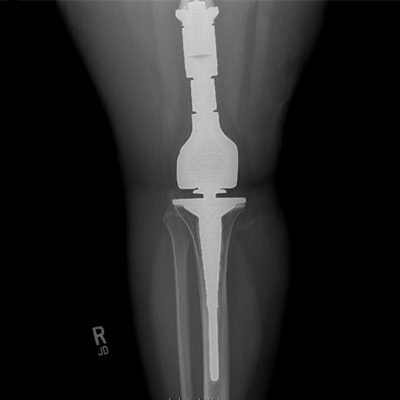Introduction
A severe accident, treatment for cancer affecting the extremities or conditions such as diabetes, neuropathy or peripheral vascular disease can sometimes put you at risk of losing a limb. Limb salvage surgery is primarily performed to retain your ability to walk or function and to increase the stability of the limb structures.

Limb salvage surgery for patient with bone sarcoma in the femur
Limb salvage may involve the removal of a tumor followed by reconstruction of the limb to preserve aesthetics and function. Traditionally surgery involved the amputation or removal of the entire arm or leg to prevent the cancer from spreading. Now with the advancement of diagnostic procedures, chemotherapy and surgical procedures, limb salvage surgery may be recommended by experienced professionals to give patients the best possible outcome.
Limb salvage may require a team surgical approach with the help of a plastic surgeon to move muscles and skin to areas of damage or cancer resection.
Indications
Your surgeon will recommend limb salvage surgery after evaluating many factors such as your age and general health; type, location and size of the tumor, and extent of the metastasis.
Procedure
For benign masses in the extremities, typically surgical resection alone is sufficient. However in the setting of a cancernous tumor, surgical resection is often augmented with additional therapies in order to optimize outcomes. Chemotherapy or radiation is given for a few months to kill the cancer cells and shrink the tumor. Then, the remaining tumor is completely removed surgically, along with a margin of healthy tissue.
The gap formed by the surgery is then reconstructed.
- If only a small amount of tissue is removed, an autograft (healthy tissue removed from another part of the patient’s body) or an allograft (tissue taken from a cadaver) can be used to reconstruct the surgical gap.
- Prosthetic implants may also be necessary if a joint requires reconstruction. There are many different implant designs and fixation constructs that may be recommended for your unique situation
- Bone graft may be shaped to the required size and attached to the bone with the help of metal rods and plates.
- Bone graft in combination with a prosthesis may be fixed with plates and screws.
- The muscles and tendons are attached to the implant and the surgical site is closed after covering the implant with healthy soft tissue.
Post-operative Care
- A sterile dressing will be applied to your incision and at times, a compressive bandage in order to minimize pain and swelling.
- After surgery, multiple different pain medications, from different medication categories will be used in combination to minimize surgical pain and optimize recovery.
- Medication and mechanical device will be used to minimize risk of developing a DVT.
- Physical therapy will be initiated immediately after surgery and will be continued on an out-patient bases in order to maximize functional recovery.
Risk and Complications
The potential risks and complications associated with limb salvage surgery include:
- Superficial or deep infection at the operated site
- Deep Vein Thrombrosis (blood clot)
- Cancer recurrence
- Artificial implant loosening due to active use of the reconstructed limb
- Limb length discrepancy, especially in growing children
- Nonunion of bone and graft, due to improper healing
- Development of contractures, (permanent tightening of joints), especially in physically inactive individuals
- Surgery repeated for amputation

